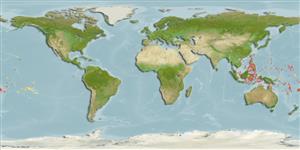>
Gobiiformes (Gobies) >
Gobiidae (Gobies) > Gobiinae
Etymology: Eviota: No etymology given, suggested by Christopher Scharpt: from Latin 'eu' for 'true' and 'iota' for anything very small, in combination 'truly very small' referring to it as being the smallest vertebrate at the time it has benn described by Jenkins (thus, making the suggestion by Scharpt plausible; irrasa: From the Latin irrasa meaning unpolished or unshaved, in reference to the indiscrete nature of the pigmentation pattern of the head and trunk (Ref. 5289).
More on authors: Karnella & Lachner.
Environment: milieu / climate zone / depth range / distribution range
Ecologie
marien rifbewoner; diepte 0 - 3 m (Ref. 58018). Tropical
Western Pacific: Cuyo Islands, Palawan, Philippines and the Southwest Islands of Palau.
Grootte / Gewicht / Leeftijd
Maturity: Lm ? range ? - ? cm
Max length : 1.8 cm TL mannelijk / geslacht onbekend; (Ref. 5289)
Korte beschrijving
Determinatiesleutels | Morfologie | Morfometrie
Dorsale stekels (totaal) : 7; Dorsale zachte stralen (totaal) : 9; Anale stekels: 1; Anale zachte stralen: 8; Wervels: 26. Characterized by the following: base of pectoral fin with two dark circular to oval spots, not sharply defined and often weakly connected, the upper spot somewhat larger than the lower; pectoral spots moderately pigmented, the intensity about equal to trunk bars; head (dorsally) and nape with dark, transverse, bars continuous over dorsal midline, and somewhat more heavily pigmented laterally; trunk with regular, dark, vertical bars, somewhat diffuse in outline, continuous over dorsal midline and usually not extending below midside anteriorly and much shorter posteriorly on peduncle; scale pockets dorsolaterally on trunk often weakly pigmented (Ref. 5289); characterized further by longitudinal scale series 24; ctenoid scales, absence on head, nape and base of pectoral fin; separated pelvic fins, only thin membrane joins bases; 8-11 branches on fourth pelvic ray; depth of body 4.1-4.7 in SL (Ref. 90102). Dorsal to anal fin-ray formula 9/8 (Ref. 116739).
Levenscyclus en paargedrag
Maturiteit | Voortplanting | Paaien | Eieren | Fecunditeit | Larven
Karnella, S.J. and E.A. Lachner, 1981. Three new species of the Eviota epiphanes group having vertical trunk bars (Pisces: Gobiidae). Proc. Biol. Soc. Wash. 94(1):264-275. (Ref. 5289)
Status op de Rode Lijst van het IUCN (Ref. 130435: Version 2024-2)
Gevaar voor de mens
Harmless
Gebruik door de mens
Tools
Speciale rapporten
Download XML
Internetbronnen
Estimates based on models
Preferred temperature (Ref.
123201): 25.1 - 29.3, mean 28.5 °C (based on 1584 cells).
Fylogenetische diversiteitsindex (Ref.
82804): PD
50 = 0.5000 [Uniqueness, from 0.5 = low to 2.0 = high].
Bayesian length-weight: a=0.00692 (0.00284 - 0.01683), b=3.10 (2.92 - 3.28), in cm total length, based on LWR estimates for this Genus-body shape (Ref.
93245).
Trofisch niveau (Ref.
69278): 3.0 ±0.3 se; based on size and trophs of closest relatives
Weerstandsvermogen (Ref.
120179): Hoog, minimale populatieverdubbelingstijd minder dan 15 maanden (Preliminary K or Fecundity.).
Fishing Vulnerability (Ref.
59153): Low vulnerability (10 of 100).
